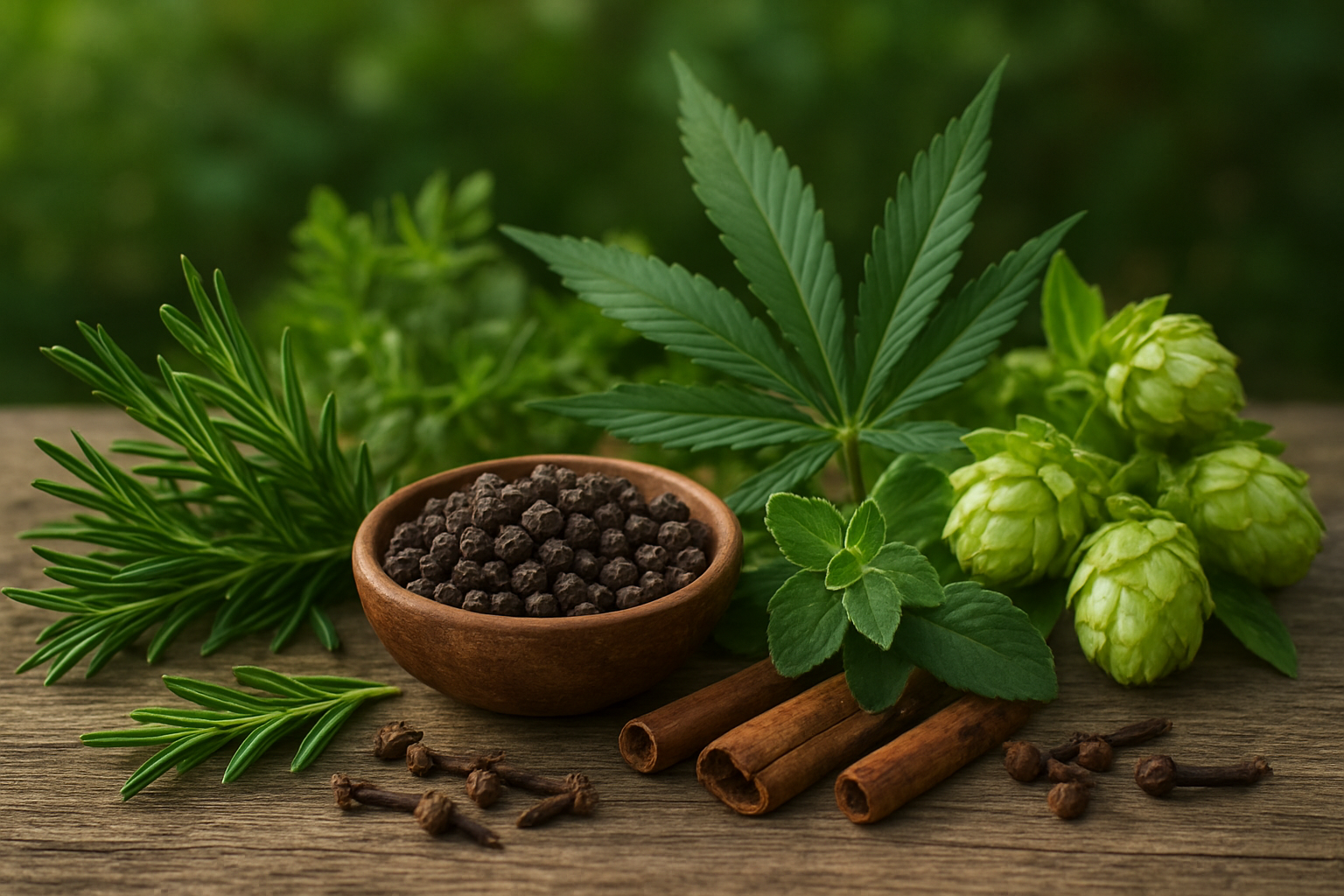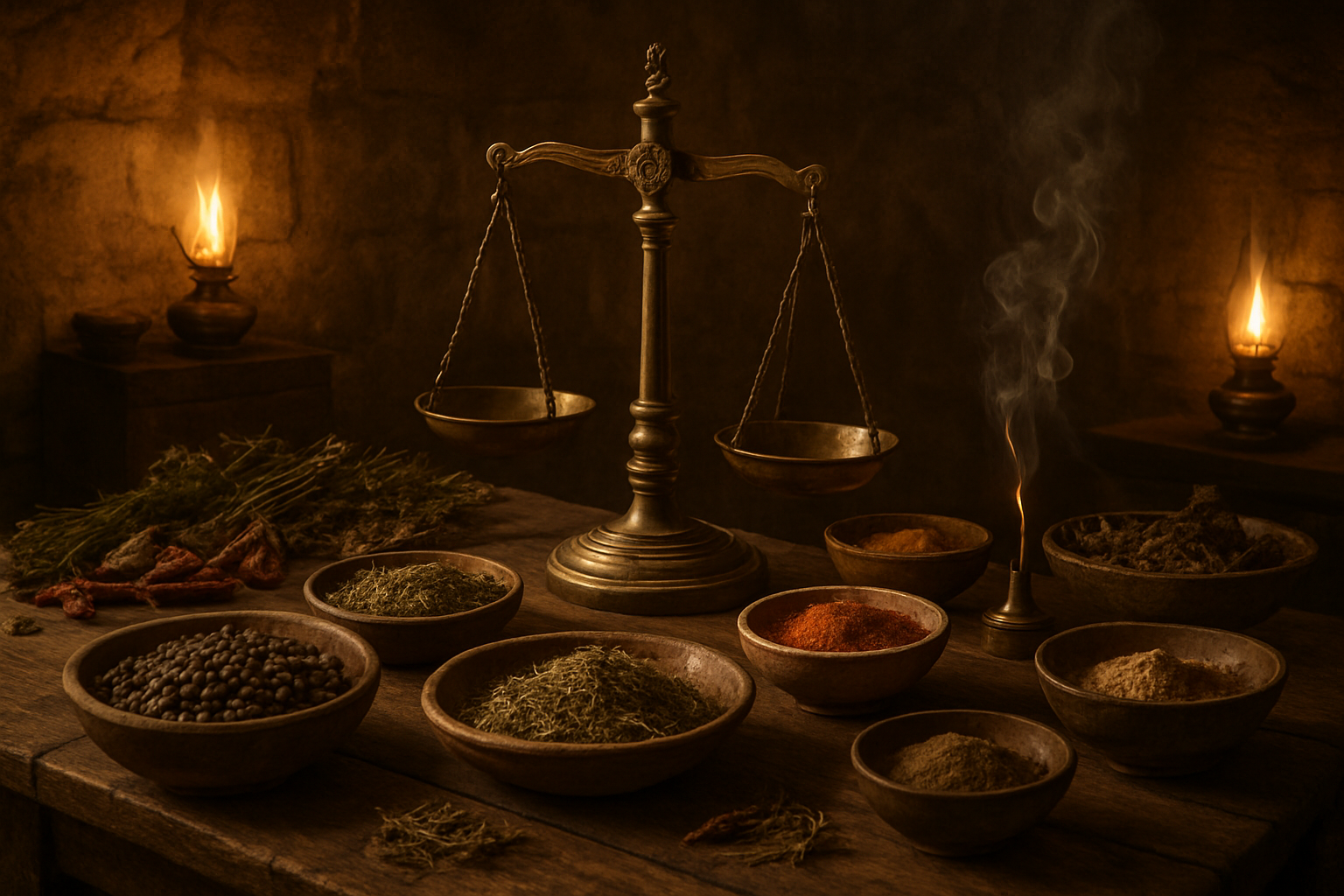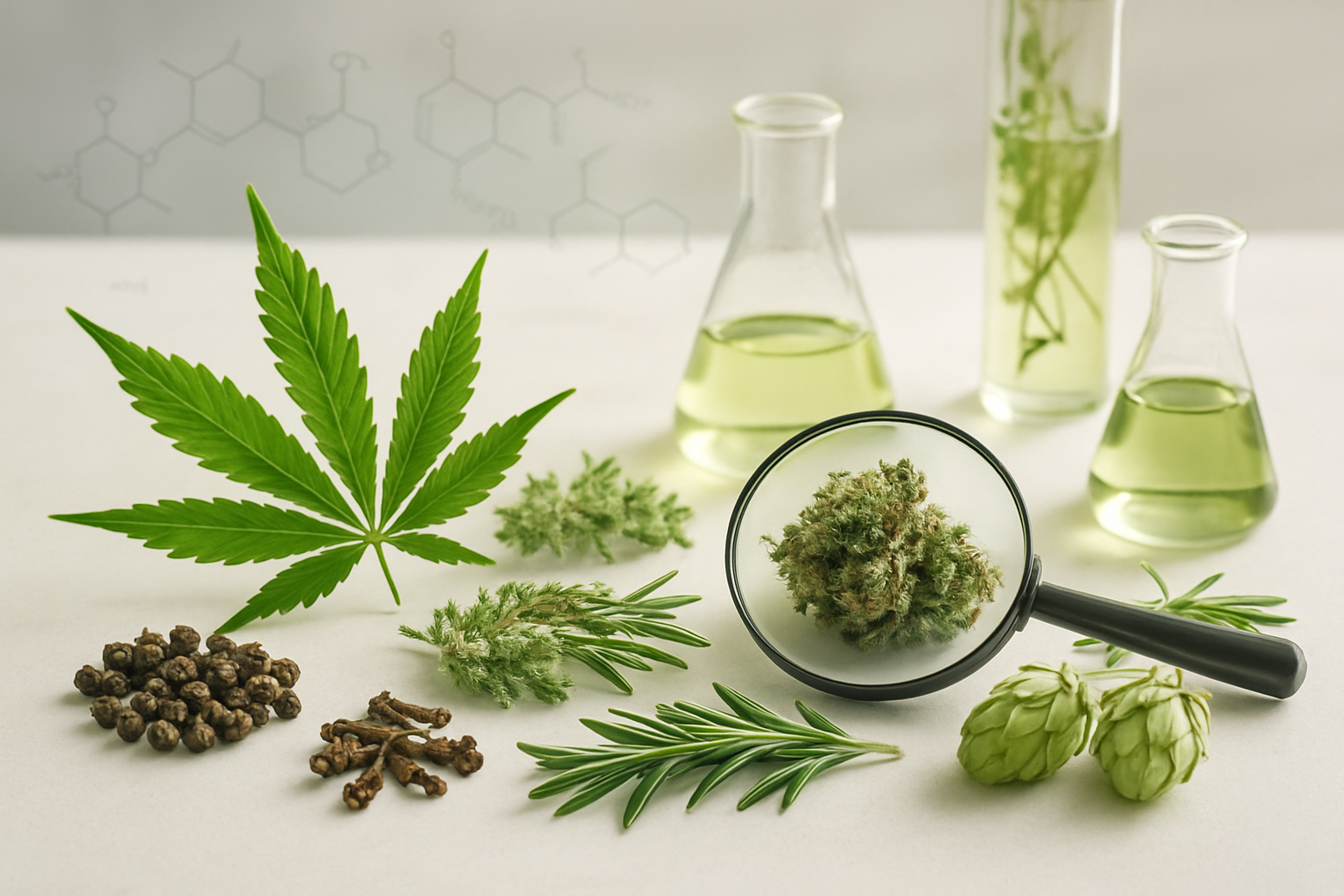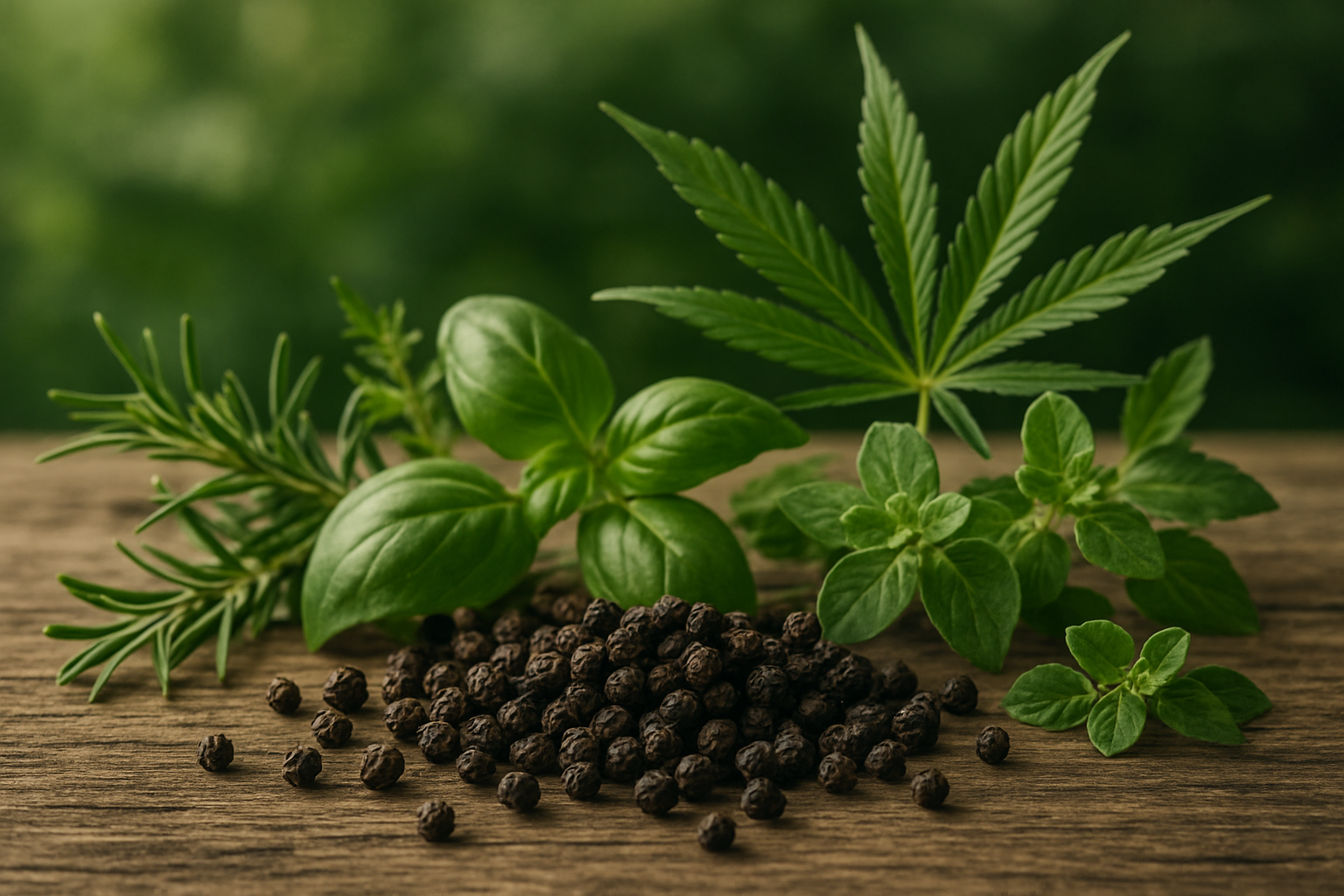Nov 18, 2025

Beta-caryophyllene stands out as one of nature's most fascinating terpenes, delivering that distinctive peppery, herbaceous aroma you'll recognize from black pepper, cinnamon, and cannabis. This unique compound does something no other terpene can do—it actually interacts with your body's cannabinoid receptors, making it behave more like a cannabinoid than a typical aromatic compound.
This guide is perfect for cannabis enthusiasts, aromatherapy practitioners, and anyone curious about the science behind plant aromatics who wants to understand what makes beta-caryophyllene special. We'll explore where you'll find this spicy terpene throughout nature—from your spice rack to cannabis plants—and dive into how ancient cultures have used caryophyllene-rich plants for centuries. You'll also learn how to identify beta-caryophyllene's signature scent profile in different cannabis strains and understand why this terpene creates such unique effects compared to others in the plant kingdom.

Beta-caryophyllene belongs to a fascinating class of aromatic compounds called terpenes, which serve as the building blocks for countless fragrances and flavors throughout the natural world. As a plant volatile, beta-caryophyllene demonstrates the remarkable ability of plants to produce complex organic molecules that contribute to their essential oil profiles. This particular terpene stands out as a major component found across diverse plant species, establishing its significance within the broader terpene family.
The compound's presence as a major plant volatile indicates its fundamental role in plant chemistry and communication. Beta-caryophyllene represents one of nature's most widely distributed aromatic molecules, appearing consistently in the essential oil compositions of numerous botanical species. This widespread occurrence suggests evolutionary advantages that have preserved its production mechanisms across different plant families.
The distinctive spicy or peppery aromatic profile of beta-caryophyllene creates its unmistakable sensory signature. This characteristic warm, spicy quality emerges from the compound's unique molecular structure, which interacts with our olfactory receptors to produce sensations reminiscent of freshly ground black pepper and warming spices.
Beta-caryophyllene's aromatic properties manifest most prominently in familiar culinary ingredients where it serves as a major component. In oregano, the compound contributes to the herb's robust, earthy warmth that enhances Mediterranean cuisine. Cinnamon's distinctive spicy-sweet character owes much to beta-caryophyllene's presence, while black pepper's sharp, peppery bite directly reflects this terpene's aromatic influence. These spice and food plants demonstrate how beta-caryophyllene's warm, spicy qualities translate into the flavors and aromas that define our culinary experiences.
Within botanical chemistry, researchers classify beta-caryophyllene through systematic analysis of its occurrence and concentration across plant species. Scientific studies focus on quantifying this compound within essential oil profiles, revealing its variable yet significant presence across different botanical families.
In Cannabis sativa L., beta-caryophyllene represents a major component of the plant's essential oil composition, with content measurements ranging between 12.5% and 35%. This substantial concentration range demonstrates the compound's importance within cannabis chemistry while highlighting how genetic and environmental factors influence terpene production. Scientists utilize this variation data to understand how different cannabis cultivars express beta-caryophyllene and how growing conditions affect its accumulation.
Researchers employ sophisticated analytical techniques to isolate and quantify beta-caryophyllene within complex essential oil matrices. These methodologies allow scientists to map the compound's distribution patterns across plant kingdoms, creating comprehensive databases that reveal its botanical significance and potential applications.

Beta-caryophyllene shows up in some of the most beloved ingredients in kitchens worldwide. Black pepper stands out as the richest source, containing up to 35% of this terpene in its essential oil composition. The familiar bite and warmth of freshly cracked pepper comes largely from beta-caryophyllene working alongside other compounds.
Cloves pack another powerful punch of this terpene, which contributes to their distinctive warm, slightly numbing sensation. Oregano, rosemary, and basil all contain notable amounts, helping create the complex flavor profiles that make Mediterranean dishes so appealing. Cinnamon bark delivers beta-caryophyllene alongside its sweet and spicy notes, while hops - essential for beer brewing - contain significant concentrations that contribute to certain beer styles' spicy, earthy characteristics.
Less obvious sources include copaiba tree resin, which produces one of the highest concentrations found in nature, and ylang-ylang flowers used in perfumery. Even some fruits like figs contain smaller amounts, adding subtle complexity to their sweetness.
The peppery heat you experience when black pepper hits your tongue isn't just about piperine - beta-caryophyllene plays a crucial role in creating that familiar sensory experience. This terpene delivers a woody, spicy warmth that builds slowly and lingers, different from the sharp, immediate heat of capsaicin in chili peppers.
In cloves, beta-caryophyllene works alongside eugenol to create that distinctive aroma that instantly transports you to holiday baking or dental offices. The terpene adds depth and complexity, preventing the scent from becoming too sweet or one-dimensional. When you smell clove oil, you're experiencing a carefully balanced chemical symphony where beta-caryophyllene provides the spicy backbone.
The terpene's molecular structure allows it to interact with both our olfactory system and our endocannabinoid system, which explains why these familiar spices can have both aromatic and physiological effects. This dual action makes beta-caryophyllene unique among terpenes.
Plants don't produce beta-caryophyllene randomly - environmental pressures drive its development as part of sophisticated defense and communication systems. Stress factors like drought, temperature fluctuations, and pest pressure typically increase terpene production as plants ramp up their chemical defenses.
Soil composition significantly impacts terpene profiles. Plants growing in nutrient-rich, well-drained soils often produce more complex terpene blends, while stressed plants in poor soils might concentrate their energy on producing specific protective compounds like beta-caryophyllene.
Light exposure creates another major influence. Plants receiving intense sunlight or specific light spectrums often boost terpene production to protect against UV damage and oxidative stress. Indoor cultivation allows growers to manipulate these factors, explaining why controlled environment agriculture can produce plants with enhanced terpene profiles.
Temperature swings between day and night can trigger increased terpene synthesis, which is why many aromatic plants grown in regions with significant diurnal temperature variations develop particularly complex scent profiles. Even harvest timing matters - terpene concentrations fluctuate throughout the day and across growing seasons.

Black pepper commanded such reverence in ancient Rome that it was literally worth its weight in gold, with peppercorns serving as currency and dowry payments. This precious spice, rich in beta-caryophyllene, traveled the Silk Road and shaped entire economies. European merchants risked treacherous ocean voyages to secure direct access to pepper's source, fundamentally altering world geography and trade relationships.
In Traditional Chinese Medicine, practitioners have valued aromatic plants containing beta-caryophyllene for over 3,000 years. They incorporated cloves into healing formulas, believing their warming properties could restore balance to the body's energy systems. Sichuan peppercorns became essential in regional cuisines, prized not just for flavor but for their supposed ability to improve circulation and digestive health.
Indigenous cultures across the Americas developed sophisticated relationships with beta-caryophyllene-rich plants long before European contact. Mexican civilizations burned copal resin in sacred ceremonies, while North American tribes used sage and other aromatic herbs for spiritual cleansing rituals. These practices recognized the powerful connection between scent and consciousness, using plant aromatics to facilitate meditation and community bonding.
Mediterranean cultures wove rosemary, oregano, and thyme into daily life, creating culinary traditions that doubled as folk medicine. Greek physicians like Hippocrates documented the therapeutic properties of these herbs, establishing foundational principles that influence modern aromatherapy and herbal medicine practices.
Ancient Egyptian embalmers understood something profound about aromatic preservation. They packed mummy wrappings with cinnamon, cloves, and other beta-caryophyllene-containing spices, recognizing their antimicrobial properties centuries before science explained why these plants resist decay. Temple priests burned frankincense and myrrh daily, creating sacred atmospheres that connected earthly worship to divine realms.
Medieval monasteries became centers of herbal knowledge, with monks cultivating extensive gardens of aromatic plants. They developed detailed records of which herbs worked best for different ailments, creating the foundation for modern pharmacology. These religious communities recognized that aromatic plants offered both physical healing and spiritual comfort, integrating them into prayer rituals and daily meals.
Wedding ceremonies across cultures have consistently featured aromatic herbs as symbols of prosperity and protection. Roman brides wore herb crowns, while Indian marriages included turmeric and other spiced preparations. These traditions acknowledged the psychological impact of scent on memory formation, ensuring that important life moments would be anchored by distinctive aromatic experiences.
Kitchen gardens in every civilization prioritized plants rich in aromatic compounds. Families passed down knowledge about which herbs paired with specific foods, not just for flavor but for digestive health. This practical wisdom created regional cuisines that naturally incorporated therapeutic compounds into daily nutrition, demonstrating an intuitive understanding of plant chemistry that modern science continues to validate and explore.

Cannabis plants produce an impressive array of terpenes because they've evolved sophisticated biochemical pathways that create these aromatic compounds as natural defense mechanisms. Each strain carries a unique genetic blueprint that determines which terpenes get produced and in what quantities. Think of it like a recipe book where different strains have access to different combinations of ingredients.
The plant's terpene production serves multiple purposes in nature. These compounds help repel insects and herbivores while attracting beneficial pollinators. Some terpenes also provide UV protection and help the plant cope with environmental stresses like drought or temperature fluctuations. This multi-functional role explains why cannabis has developed such a rich terpene vocabulary over thousands of years of evolution.
Individual plants can produce anywhere from 50 to over 200 different terpenes, though typically only a dozen or so appear in significant concentrations. The dominant terpenes create the primary aroma profile, while minor compounds add subtle notes that contribute to the overall complexity. This creates endless possibilities for unique scent combinations, much like how a perfumer blends different notes to create a signature fragrance.
Genetics lay the foundation for a plant's terpene potential, but environmental factors play a crucial role in bringing those genetic possibilities to life. Two identical clones grown in different conditions can develop noticeably different aroma profiles, even though they share the same DNA.
Temperature significantly impacts terpene production and retention. Higher temperatures during flowering can cause volatile terpenes to evaporate before harvest, leading to diminished aromatic intensity. Many cultivators maintain cooler growing environments during the final weeks to preserve these delicate compounds. Humidity levels also matter - too much moisture can promote mold growth, while too little can stress plants and alter their chemical production.
Light spectrum and intensity directly influence terpene synthesis. Plants grown under full-spectrum LED lights often develop different terpene profiles compared to those grown under traditional high-pressure sodium lights. UV exposure, in particular, can boost the production of certain protective terpenes.
Nutrient availability shapes terpene development as well. Phosphorus and potassium levels during flowering affect the plant's ability to produce aromatic compounds. Some growers manipulate feeding schedules to enhance specific terpene expressions, though this requires careful balance to avoid stressing the plant.
Harvest timing creates another variable in the equation. Terpene concentrations fluctuate throughout the plant's lifecycle, with some compounds peaking early while others develop later in flowering. Cultivators often monitor trichome development and perform smell tests to determine optimal harvest windows for desired terpene profiles.
Gas chromatography paired with mass spectrometry (GC-MS) serves as the gold standard for terpene analysis in cannabis laboratories. This technique separates individual terpenes based on their molecular weights and boiling points, allowing scientists to identify and quantify specific compounds with remarkable precision.
The process begins with sample preparation, where dried cannabis material gets heated to vaporize the terpenes without destroying them. The resulting vapor travels through a long column where different terpenes separate based on how they interact with the column's coating material. Lighter molecules like pinene travel faster, while heavier compounds like caryophyllene take longer to emerge.
As each terpene exits the column, it enters a mass spectrometer that fragments the molecules and creates unique fingerprints. Scientists compare these patterns against extensive databases to identify each compound. The intensity of the signals indicates concentration levels, typically reported as percentages or milligrams per gram of plant material.
Sample handling requires extreme care since terpenes are volatile and can degrade quickly when exposed to heat, light, or oxygen. Laboratories store samples in sealed containers at low temperatures and analyze them as soon as possible after collection. Some facilities use specialized headspace analysis techniques that capture terpenes directly from the air above cannabis samples, providing insights into what consumers actually smell when they open a container.
Quality control measures include running blank samples, standards, and duplicates to ensure accuracy and reproducibility. Many labs also participate in proficiency testing programs where they analyze identical samples alongside other facilities to validate their methods and results.

Beta-caryophyllene brings a distinctive peppery punch to cannabis strains that's hard to miss once you know what you're looking for. The aroma carries sharp, spicy notes that can remind you of freshly cracked black pepper or the woody intensity of cloves. Some users describe catching hints of cinnamon bark or the warm spice blend you'd find in chai tea.
What makes beta-caryophyllene particularly interesting in cannabis is how it adds complexity without overwhelming other aromas. You might notice a subtle heat on the back end of a strain's scent profile, or catch that characteristic peppery bite when grinding flower. The terpene often creates what many describe as a "warm" quality to the overall bouquet, adding depth that distinguishes certain strains from their sweeter or more citrusy cousins.
Common descriptors for beta-caryophyllene in cannabis include woody, herbaceous, and sometimes even slightly metallic notes. The intensity can vary dramatically between strains - some deliver just a whisper of spice, while others hit you with bold peppery aromatics that dominate the scent profile.
The magic happens when beta-caryophyllene teams up with other terpenes to create complex aromatic symphonies. Paired with myrcene, it often produces earthy, musky combinations that feel grounded and robust. The spicy edge of caryophyllene balances myrcene's sometimes overwhelming earthiness, creating strains that smell rich without being heavy.
Limonene and beta-caryophyllene make for particularly intriguing partnerships. The bright citrus notes of limonene get a spicy backdrop that transforms simple fruit aromas into something more sophisticated - think orange zest with a dash of exotic spice. This combination often appears in strains that smell both refreshing and complex.
When caryophyllene meets pinene, the result often evokes walking through a spiced forest. The fresh, piney sharpness gets warmed up by peppery undertones, creating profiles that smell simultaneously invigorating and comforting. These combinations frequently appear in strains known for their balanced, well-rounded aromatics.
| Terpene Combination | Resulting Aroma Profile |
|---|---|
| Beta-caryophyllene + Myrcene | Earthy, spicy, musky |
| Beta-caryophyllene + Limonene | Citrus with peppery complexity |
| Beta-caryophyllene + Pinene | Fresh pine with warm spice |
| Beta-caryophyllene + Linalool | Floral with spicy depth |
Even strains within the same genetic family can smell completely different depending on their beta-caryophyllene content and how it interacts with other terpenes present. Growing conditions play a huge role here - the same strain grown in different environments can produce vastly different terpene profiles.
Harvest timing affects beta-caryophyllene expression significantly. Plants harvested earlier might show more subtle spicy notes, while those left longer could develop more pronounced peppery characteristics. Temperature, humidity, and light exposure during the growing cycle all influence how much beta-caryophyllene a plant produces and how it balances with other terpenes.
Phenotype variation within the same strain creates another layer of complexity. Two plants from identical seeds might express beta-caryophyllene differently, leading to one smelling predominantly woody while its sister plant leans more heavily into peppery territory. This genetic lottery explains why experienced users often hunt for specific cuts of strains rather than settling for any version of a particular name.
Curing and storage methods also impact how beta-caryophyllene presents itself. Proper curing can enhance and preserve these delicate spicy notes, while poor storage might let them degrade or become muted. The interplay between preservation techniques and terpene stability means that two batches of the same strain can offer completely different aromatic experiences to consumers.

Beta-caryophyllene is one of those rare botanical compounds that shows just how interconnected the natural world really is. From the spices in your kitchen to the herbs that shaped ancient trade routes, this terpene has been part of human culture far longer than cannabis has been studied in a modern context. Its warm, peppery aroma helps define the character of countless plants, and understanding where it comes from—and how it develops—adds a richer layer of appreciation to the aromas people notice in today’s cannabis cultivars.
As research tools advance and consumers become more curious, terpenes like beta-caryophyllene continue to spark interest among those who enjoy learning about plant chemistry and aromatic diversity. Whether someone is drawn to its peppery notes, its cultural legacy, or its role in shaping cannabis aroma, beta-caryophyllene remains a standout example of how much depth there is to discover in the world of botanical compounds.